The information on this page describes the legal requirements in the Land Transport Rule: Vehicle Dimensions and Mass 2016 that apply to heavy rigid vehicles.
Please also read:
general dimension and mass limits and general towing requirements
specialist vehicles that need a permit to operate on the road
Heavy vehicles are those with a maximum gross vehicle mass (GVM), usually specified by the manufacturer, over 3500 kilograms (kg).
A rigid vehicle has two axle sets, a driver’s position, a steering system, motive power and a single rigid chassis. A small range of special vehicles with a chassis split into two dependent parts and connected by means of a permanent steering pivot, are also legally rigid vehicles, for example an articulated bus.
Heavy rigid vehicles include heavy trucks (classes NB and NC), heavy buses (classes MD3, MD4 and ME), heavy mobile homes, mobile cranes, fire engines, heavy forklifts, heavy tractors, heavy self-powered agricultural and construction machines and vehicles with pivot steering.
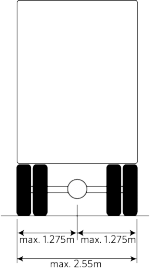
The maximum width (including any load) is 2.55 metres, or 1.275 metres from each side of the longitudinal centre-line of the vehicle (excluding side marker lights, direction indicators and the bulge towards the bottom of a tyre).
The only extra width allowed is:
side marker lamps and direction indicators
collapsible mirrors that extend not more than 240 millimetres beyond the side of the vehicle or its trailer, and 1.49m when measured from the vehicle’s longitudinal centre line
central tyre inflation system hoses that extend not more than 75 millimetres beyond the outside of the tyre on the drive axles of a heavy motor vehicle
a hubodometer that extends not more than 50mm beyond one side of a vehicle from a non-lifting, non-steering axle whose outer casings are of a light colour, provided the hubodometer is fitted on the axle that causes the least overwidth
cab exterior grabrails that extend not more than 1.325m when measured from a vehicle’s longitudinal centre-line
the bulge towards the bottom of a tyre
cameras or close-proximity monitoring systems mounted on the side exterior of a vehicle that extends not more than 70mm from the side wall of the vehicle
devices for improving the aerodynamic performance of a vehicle that extend not more than 25mm from either side of a vehicle.
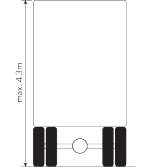
The maximum height above ground is 4.3 metres.
The height of the body or load of class NC trucks (goods service vehicles with a GVM over 12 tonnes) or their operating gross mass may be restricted by stability requirements, particularly the need for the vehicle to have a minimum static roll threshold (SRT).
Read more about static roll thresholds
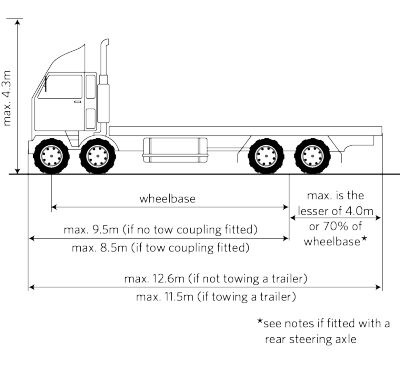 The maximum length (including load) of a heavy rigid vehicle is 12.6 metres, except buses; see heavy buses for more information. However, if the vehicle will be towing a trailer or another motor vehicle, its maximum length must not exceed 11.5 metres. (See heavy trailers and combinations for the maximum allowed overall length of a particular heavy combination vehicle.)
The maximum length (including load) of a heavy rigid vehicle is 12.6 metres, except buses; see heavy buses for more information. However, if the vehicle will be towing a trailer or another motor vehicle, its maximum length must not exceed 11.5 metres. (See heavy trailers and combinations for the maximum allowed overall length of a particular heavy combination vehicle.)
Forward distance, for a rigid vehicle, means the distance from the rear axis to the front of the vehicle or its load, whichever is foremost (excluding collapsible mirrors).
The maximum forward distance, for heavy rigid vehicles without a tow coupling, is 9.5 metres. Heavy rigid vehicles with a tow coupling are restricted to a maximum forward distance of 8.5 metres.
Rear overhang means the distance from the rear axis to the rear of the vehicle or its load, whichever is greater. It depends on the definitions of rear axis and wheelbase.
For a heavy rigid vehicle whose rearmost axle is a non-steering axle, the maximum rear overhang is the lesser of four metres or 70 percent of the wheelbase. (In the diagram above, the rear axis is at the midpoint of the two or more axles).
For a heavy rigid vehicle whose rearmost axle is a steering axle, the maximum rear overhang is the lesser of 4.25 metres or 70 percent of the wheelbase. (In the diagram above, the rear axis is at the midpoint of the two or more axles).
For a heavy rigid bus in excess of 12.6 metres (that must have a rearmost steering axle) the maximum rear overhang is the lesser of 4.5 metres or 72 percent of wheelbase.
The maximum front overhang, measured from the front edge of the driver’s seat (in its rearmost position) to the foremost point of the vehicle or its load, is three metres (except for an agricultural motor vehicle where four metres is allowed).
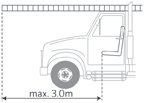

The minimum ground clearance is 100mm. The ground clearance must also be at least 6 percent of the distance from the nearest axle to the point where the ground clearance is measured (except when loading or unloading). Items not included in the ground clearance requirement are: flexible mudflaps, wheels, tyres and devices designed to discharge static electricity.
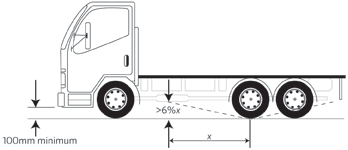
A vehicle (including projections) must be able to complete a 360-degree turn, both to the left and to the right, within a circle with a kerb-to-kerb diameter of 25 metres. The only projections which can be outside this circle are collapsible mirrors.
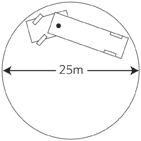
A heavy rigid vehicle must have a front axle set consisting of a:
single axle set, which may steer, or
twin-steer axle set.
A heavy rigid vehicle must have a rear axle set consisting of a:
single axle set, or
tandem axle set, or
tri-axle set.
Forklifts may have a rear steering axle. Their rear axis is at the non-steering axle (usually the front axle).
Heavy rigid vehicles with a coupling for towing a heavy trailer must not have a rear steering axle.
Heavy rigid vehicles may have one steering axle in the rear axle set. Note that the rear axis is at the centre point of the non-steering axles in the rear axle set. Rear overhang and forward distance requirements must be met by vehicles with rear steering axles.
Heavy rigid vehicles with rear steering axles may only tow one light trailer.
Some mobile cranes can allow all axles to steer at very low speeds in an off-road location. For travel on a road, at least one of the axles must be locked so its wheels are parallel with the longitudinal centre line of the vehicle.
All rear axle sets must have a suspension system that provides effective damping and shares the load between the wheels of the set, so that no tyre carries a mass more than 10 percent greater than the mass it would carry:
if all the tyres in the set were the same width and the load was shared equally between the tyres, or
if a tandem axle set contained a twin-tyred axle and large single-tyred axle (‘super single’) and was built to divide the load between the tyres in the set in either the 60 percent twin/40 percent large single ratio or 55 percent twin/45 percent large single ratio. (A vehicle with these axle sets must have an indelible plate fixed to it by the manufacturer – see the Vehicle Dimensions and Mass 2016 Rule).
Heavy rigid vehicles may have retractable axles in the drive axle or rear axle set if:
the retractable axle has an automated control to ensure that the axles remaining on the ground stay within the appropriate legal mass limits and manufacturer’s limits, and
forward distance and rear overhang limits are complied with when the axle is on the ground and when it is retracted (the position of the rear axis may change depending on whether the axle is retracted or touching the ground), and
such retractable axles are certified for compliance with the requirements in both of the above points.
Please note that only unladen vehicles can operate with an axle retracted (but a tractor unit with a retracted rear axle can tow an unladen semi-trailer).
For towing a light full trailer or light simple trailer: The coupling position can be at the rear of the vehicle, provided the maximum rear overhang, forward distance and overall length limits are not exceeded.
For towing a heavy full trailer: The coupling must be no further behind the rear axis of the truck than 45 percent of the wheelbase of the truck. The wheelbase is measured from the rear axis of the truck to the foremost axle of the truck.
For towing a heavy simple trailer (including Stinger Steer Transporters): The coupling must be at least 700 millimetres rearward of the rear axis of the truck and at a distance of not more than 50 percent of the wheelbase of the truck.
Note: For Stinger Steer Transporters, ‘tow coupling’ includes an articulated fifth wheel attachment with a kingpin, or a ball attachment.
For towing a semi-trailer (excluding Stinger Steer Transporters):
For a rigid vehicle with one axle in its rear set, the coupling position must not be behind the centre of that axle.
For a rigid vehicle with two or three axles in its rear set, the coupling position must not be more than 300mm behind the rear axis of the towing vehicle.
It is recommended that a heavy rigid vehicle has, at all times, at least 20 percent of its gross mass on the front axle or twinsteer axle set of the vehicle. This gives the front wheels enough grip on the road to steer the vehicle.
Heavy rigid vehicles first registered on or after 1 July 2002 must have 20 percent of their mass on their front axle(s) at all times.
Most class NC trucks (goods service vehicles with a maximum gross mass exceeding 12 tonnes) must have a static roll threshold, when laden, of at least 0.35g (where g is the acceleration due to gravity). For more information see Static roll thresholds.
Heavy buses (with a gross vehicle mass greater than 3.5 tonnes) must comply with the stability requirements in the Passenger Service Vehicles Rule (Rule 31001, 1999), see Heavy buses.
Our page on vehicle dimensions and mass describes the hazard warning devices you need to attach to projecting loads within the maximum dimensions allowed for a heavy rigid vehicle. Find out more about the requirements for overdimension vehicles and loads.
Heavy rigid vehicles are limited to a maximum open road speed of 90km/h. They still need to obey lower speed limits set on particular roads.
Heavy rigid vehicles without springs or effective cushioning suspensions (eg some agricultural and construction machines) are limited to a maximum speed of 45km/h.